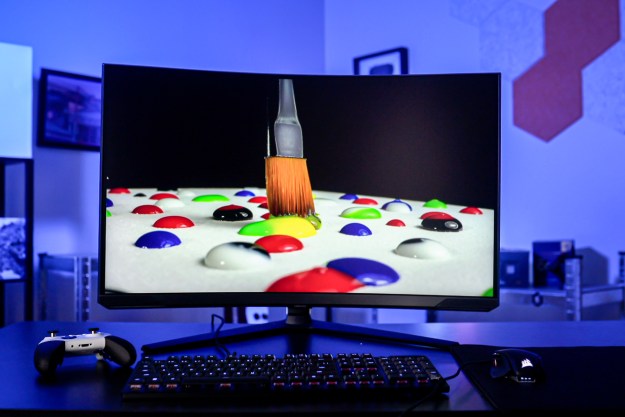
“Wonderful HDR performance meets cutting-edge display tech on the Samsung Odyssey Neo G8, assuming your PC is up to the task.”
- Fantastic HDR performance
- 240Hz is great for 4K gaming
- Solid stand and adjustments
- Moody CoreSync lighting
- Vibrant colors, if a little inaccurate
- FreeSync Premium Pro and unofficial G-Sync support
- Lazy cable management solution
- Few gaming PCs can take advantage of refresh rate
- A few random flickers on Windows desktop
The moment I laid eyes on the Samsung Odyssey Neo G8 earlier this year, I knew it was destined to become a candidate for the title of best gaming monitor. It marks a new milestone in gaming display — 4K at 240Hz, something that up to this point has never been done.
It’s more than just a high refresh rate monitor, too. HDR performance is off the charts, especially for a VA panel, and the gaming experience is unmatched; assuming you have a rig to take advantage of everything Neo G8 has to offer. It’s the luxury sports car of gaming monitors, but just like those vehicles, the Neo G8 doesn’t make sense for everyone.
Video review
Specs
| Screen size | 32 inches |
| Panel type | VA |
| Resolution | 3840 x 2160 (4K) |
| Peak brightness | 350 nits (SDR), 2,000 nits (HDR) |
| HDR | Yes (HDR10) |
| Response time | 1ms |
| Refresh rate | 240Hz |
| Curve | 1,000R |
| Speakers | None |
| Inputs | 2x HDMI 2.1, 1x DisplayPort 1.4a |
| USB ports | 2x USB 3.0 |
| Adjustments | 4.7 inches height, 21 degrees tilt, 20 degrees swivel, 90 degrees pivot |
| Wireless | N/A |
| Dimensions (WxHxD) | 29.1 x 23.9 x 12.2 inches |
| List price | $1,500 |
Design

There’s no denying that the Odyssey Neo G8 looks like a monitor worth $1,500. It fits into the design language of previous Odyssey monitors with an aggressive 1000R curve on the screen and a glossy white finish on the back. There are a couple of subtle Odyssey logos around the back of the monitor and the stand, too, which make it look just a little less generic.
Another design note the Neo G8 carries from other Odyssey monitors is CoreSync lighting. It runs around the ring where the stand connects to the display, and you can sync up the color with whatever is in the center of your screen. The Alienware 34 QD-OLED has similar ring lighting, though it doesn’t sync with your screen. If you don’t like the syncing, you can set the ring to a static color, as well.

Setting up the monitor isn’t completely toolless, but it’s still easy due to some pre-threaded screws in the base and stand. Pop them in with a screwdriver, and you’ll be set up in a minute or two. The stand is excellent with plenty of room for adjustment, including 4.7 inches of height, 22 degrees of tilt, 30 degrees of swivel, and a full 180 degrees of rotation. No, you can’t flip the monitor upside down, but you can turn it vertically to either side (with a little bit of wrestling, that is).
The stand extends out with two long, narrow legs, which take up a lot of room. At 32 inches, the Neo G8 has a large footprint on your desk, but at least it doesn’t carry a massive stand like the Corsair Xeneon 32.

Around the back of the monitor, you’ll find a small rubber loop for cable management, and there’s a bit of plastic to cover the ports in the box. It’s not a bad cable management solution, but Samsung could have done better here. The much cheaper Odyssey G7 comes with a brilliant routing channel that runs through the stand, which just makes the cable management solution on the Neo G8 just feel a little lazy, frankly.
Controls and menu
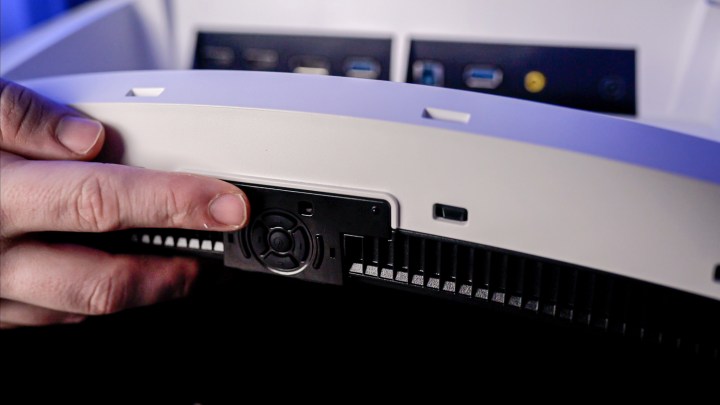
Samsung’s on-screen display (OSD) is one of my favorites among gaming monitors because it’s so easy to use. Instead of a four-way joystick like you typically find, the Neo G8 includes four directional buttons with a central nub. Controlling the monitor is a breeze because Samsung places the controls directly under the center of the display, not vaguely off to the right as you see with monitors like the Gigabyte M32U. You don’t need to hunt to quickly change your settings.
The main reason I appreciate Samsung’s OSD is that you can quickly adjust your picture settings. Click up, and you can adjust brightness, contrast, and saturation without going through the full menu. Navigating the full menu is still easy, and it opens up options like turning off local dimming (even with HDR turned on) and cycling through the various picture modes.

You have an assortment of picture modes available, but most of them don’t look great. The FPS mode is washed out, the RPG mode has way too much contrast, and the Cinema mode just turns the color temperature way too warm. The monitor comes pre-calibrated, so I recommend tweaking from the default settings. There’s an sRGB mode, as well, if you need to work specifically in that color space.
Samsung has monitor controls nailed — minus the obtuse controls on the Samsung M8 Smart Monitor — but I’ve seen a recent trend toward applications that allow you to access these settings from the desktop. The Sony InZone M9 and MSI Optix MPG 32 QD are two monitors that showed off these apps earlier this year, and that’s something I would’ve liked to see on the Neo G8.
Ports
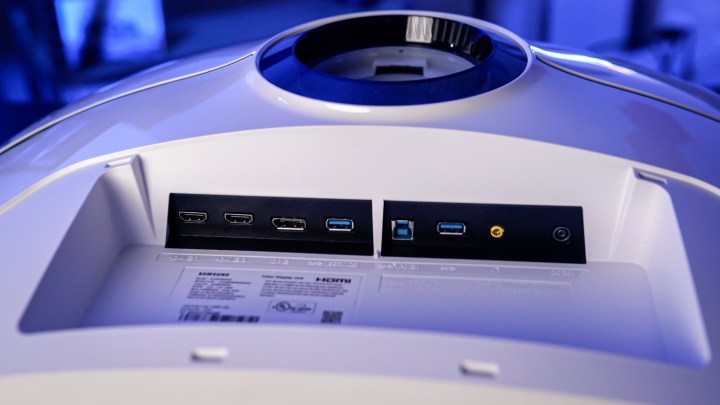
Port selection on the Neo G8 is good if a little unexciting. You have a pair of HDMI 2.1 ports that can drive 4K at 120Hz for consoles like the PlayStation 5 and Xbox Series X, but you need the DisplayPort 1.4 connection if you want to use 4K at the full 240Hz. Thankfully, you can toggle between 120Hz and 240Hz quickly through the OSD, which you may have to do (more on that in the next section).
You also get a pair of USB 3.0 ports, so you can connect your peripherals to the monitor and tether the display to your PC.
Image quality
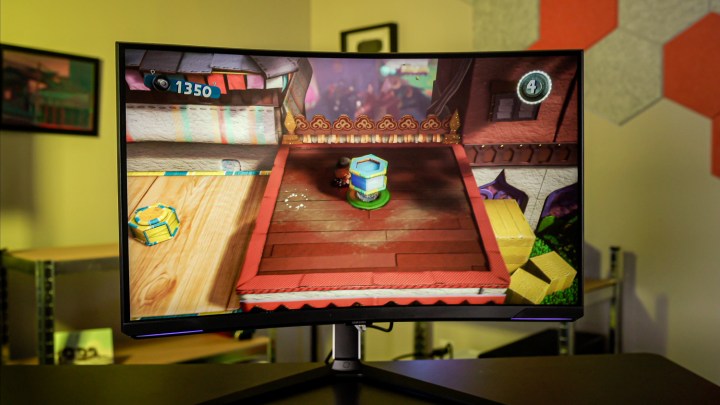
Samsung has some bold claims about the Neo G8 when it comes to HDR performance, but the SDR performance is pretty tame. It uses a VA panel, and I measured a peak brightness of 350 nits in SDR, and a 3,500:1 contrast ratio. Brightness is typical for this type of panel, but the contrast is just a bit higher than normal. And you can turn on local dimming in SDR, which boosts the contrast into the 6,500:1 range.
Local dimming is a big part of the Neo G8. It’s a mini-LED monitor, which enables it to stretch up to 1,196 local dimming zones, putting the 96 zones on the Sony InZone M9 to shame. Out of the box, the local dimming is set to Auto mode, which will toggle local dimming on whenever you turn HDR on. You can override that setting, though, choosing to turn local dimming off or to one of two intensities.
Samsung says the Neo G8 comes factory calibrated, which I hoped would mean great color performance out of the box. That’s what I saw with the pre-calibrated Acer Predator X28 earlier this year, but the Neo G8 left me disappointed. Overall, color error was 2.12, which is a little too high for color work. The good news is that none of the colors were super off, everything hovered between a Delta-E of 1 to 3. Everything looks balanced, even if it’s not quite up to snuff for professional color work.
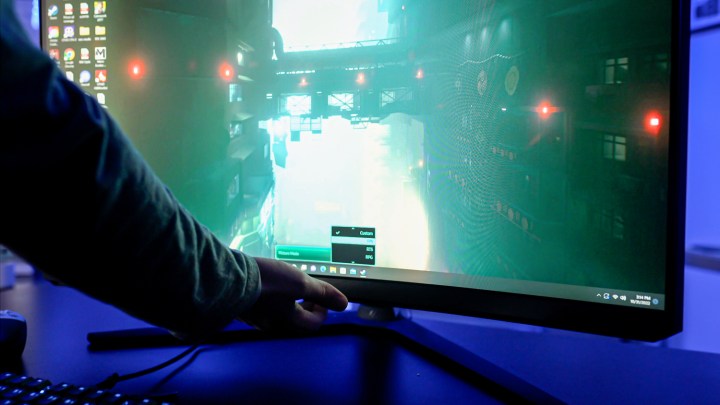
It’s a shame that the color accuracy isn’t better because the Neo G8 covers a lot of colors. I measured 100% of sRGB, 90% of DCI-P3, and 82% of AdobeRGB. Unfortunately, VA panels just don’t have the color accuracy that IPS panels do. You can do some color work on the Neo G8, but it’s not the monitor for pros. This is a gaming monitor first and foremost.
Image quality is solid, but I encountered an annoying bug during testing. At 240Hz with HDR turned off, the monitor would occasionally flicker when I scrolled webpages or messed around in Windows. The flickering never showed up in games, and going down to 120Hz fixed the issue in Windows. It wasn’t too bad to work around, and it might not apply to all Neo G8 models, but hopefully, this is a bug in the firmware that Samsung can address in the future.
HDR performance

HDR on the Odyssey Neo G8 looks crazy based on the spec sheet, which is why it was such an impressive monitor when I first saw it earlier this year — 2,000 nits of peak brightness, contrast that can rival OLED monitors, and “Quantum HDR 2,000.” These specs are pretty much useless, as evidenced by the Quantum HDR rating (a rating Samsung made up for itself that’s much too similar to the industry-standard DisplayHDR certification).
In reality, the Neo G8 doesn’t hit 2,000 nits of peak brightness (at least for any portion of the screen that matters), it doesn’t have any DisplayHDR certification, and it doesn’t reach a 1,000,000:1 contrast ratio as OLED panels have. The Neo G8 is misrepresented. But, disappointing? No.
The Neo G8 is super bright, has great local dimming, and achieves contrast that’s leagues ahead of some of the best HDR monitors.
I measured a peak brightness of 800 nits on a full screen with HDR turned on, so hot spots are likely climbing above 1,000 nits. I have no doubt that the Neo G8 can hit 2,000 nits, but only in very small portions of the screen for very brief times. The Neo G8 is scorching on the eyes with HDR turned on and the brightness cranked up, so it’s not comfortable going for maximum brightness anyway.
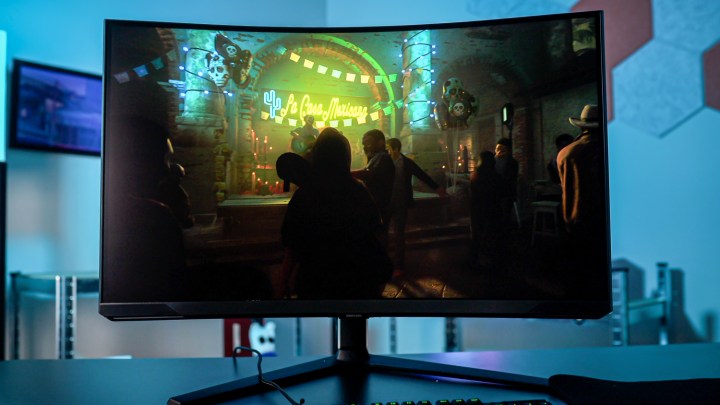
It’s not that the Neo G8 gets super bright; it’s that it gets super dark. I measured black levels at 0.05 nits, allowing HDR to get up to a contrast ratio of nearly 20,000:1 with HDR turned on. You’re not getting the perfect black levels that you’ll find on the Alienware 34 QD-OLED (or any OLED panel, for that matter), but that’s a limitation of VA panels. The Neo G8 could never achieve the contrast of an OLED, but it doesn’t need to. The local dimming is very good, and the HDR looks fantastic.
Samsung fudged the numbers on the Neo G8 a lot, which we saw with the Odyssey Neo G9 that came before. You can basically ignore the spec sheet, but don’t discount the monitor. It doesn’t achieve anywhere near a 1,000,000:1 contrast ratio (it never could), but the monitor is super bright, comes with great local dimming, and achieves contrast that’s leagues ahead of even some of the best HDR monitors.
Gaming

I was disappointed with the Neo G8 when I first set it up and started using it, but that all changed the moment I booted up Cyberpunk 2077. This is a beautiful monitor for gaming, especially with HDR turned on. The black levels make contrast pop, the colors are fully saturated and vibrant, and the ultra-high refresh rate makes games look as smooth as possible.
A lot of my testing was with an RTX 4090, which is an ideal premium gaming experience when paired up with the Neo G8 and DLSS 3 in games like Cyberpunk 2077. This is how peak immersion looks in PC gaming, and it’s not just Cyberpunk. Shadow of the Tomb Raider was gorgeous, and even games that don’t support HDR like Sackboy: A Big Adventure pop off the screen with great color and moody contrast.
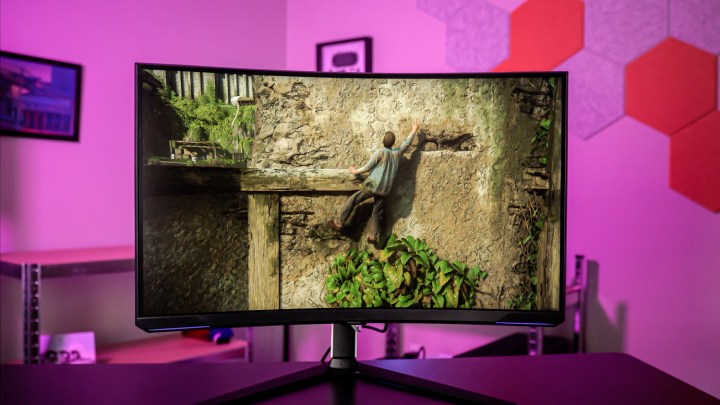
The Neo G8 is a fantastic gaming monitor. Outside of the image quality, it supports FreeSync Premium Pro, and I tested it with G-Sync, as well. It’s not certified as G-Sync Compatible, but it works.
No doubt the standout feature for gamers is the 240Hz refresh rate. The Neo G8 is the first 4K gaming monitor with a 240Hz refresh rate we’ve seen, and up until a few weeks ago, that refresh rate just didn’t make sense. Even the best graphics cards couldn’t deliver frame rates high enough to take advantage of 240Hz at 4K, outside of games like Rocket League and Rainbow Six Siege (and let’s be honest, those games aren’t a big reason to spend $1,500 on a gaming monitor).
This is a beautiful monitor for gaming, especially with HDR turned on.
The RTX 4090 changes that. It can deliver frame rates near and sometimes above 200 fps in games like Shadow of the Tomb Raider and God of War with Deep Learning Super Sampling (DLSS) turned on. This graphics card makes the Neo G8 make sense, making for a perfect combination for gamers willing to spend up for the best of the best.
But it’s hard to justify $1,500 that has a $1,600 GPU as a prerequisite. You don’t need the RTX 4090 for the Neo G8, but even the fastest, most expensive graphics cards will rarely reach a frame rate high enough to take advantage of a 240Hz refresh rate at 4K. Samsung offers its Odyssey Neo G7 for around $1,300 which boasts identical specs at a 165Hz refresh rate. That extra $200 buys you a higher refresh rate that only a very small number of gaming PCs can even drive.
Who is the Odyssey Neo G8 for?
The Odyssey Neo G8 has a bit of an identity crisis. On one hand, it’s focused on an immersive gaming experience with fantastic HDR performance, and on the other, it delivers very high refresh rates for the most competitive gamers. It can do both, and very few monitors can. Most people will fall on one side of the fence or the other, though, and there are monitors that can deliver in the same way the Neo G8 does on either side for less money.
For immersive gaming experiences, the Odyssey Neo G7 is hard to beat. You’re getting the same great HDR performance and a competitive 165Hz refresh rate for around $400 less. That’s a better buy for most people, but that doesn’t mean the Neo G8 is worthless. For a select few gamers who want th bleeding-edge performance no matter what the cost, the Odyssey Neo G8 delivers an experience that no other monitor can match right now.
Editors' Recommendations
- No, The Last of Us PC requirements aren’t changing
- Windows 12: the top features we want to see in the rumored OS
- The best gaming PCs for 2023: Dell, Origin, Lenovo, and more
- The best VR headsets for 2023
- Best graphics cards 2023: finding the best GPU for gaming





